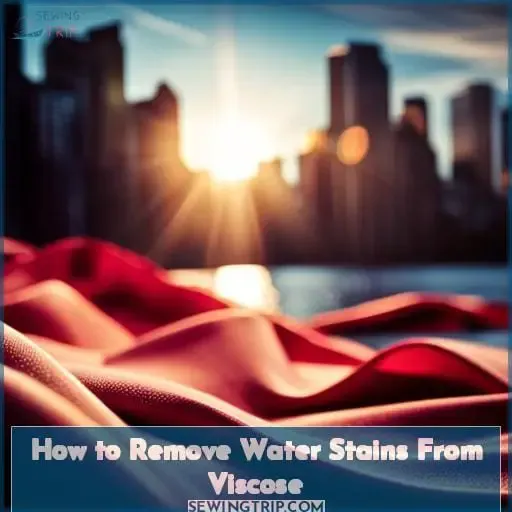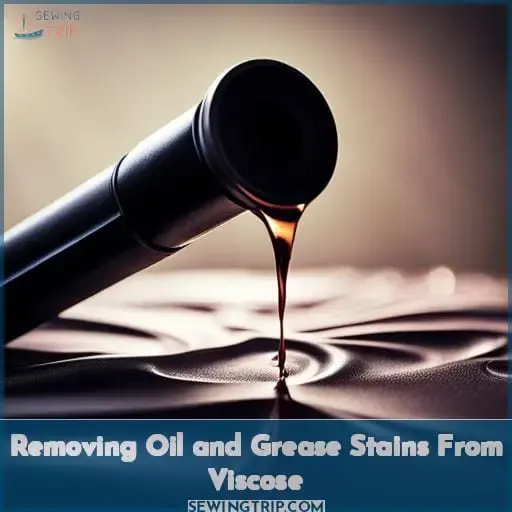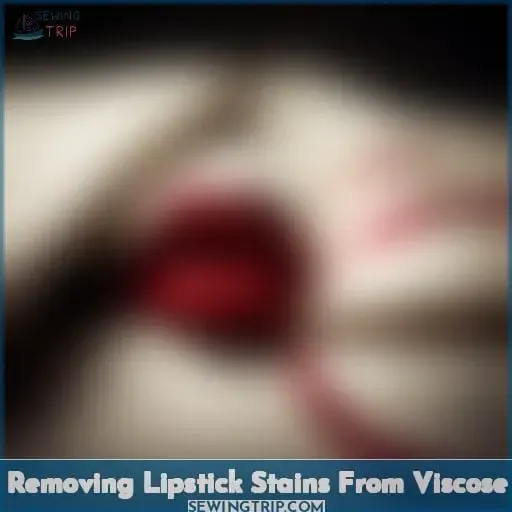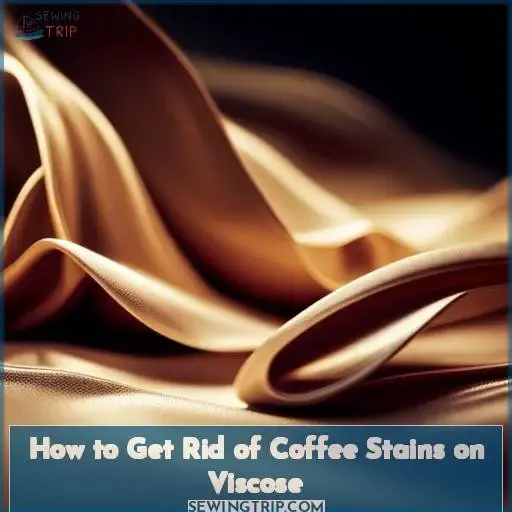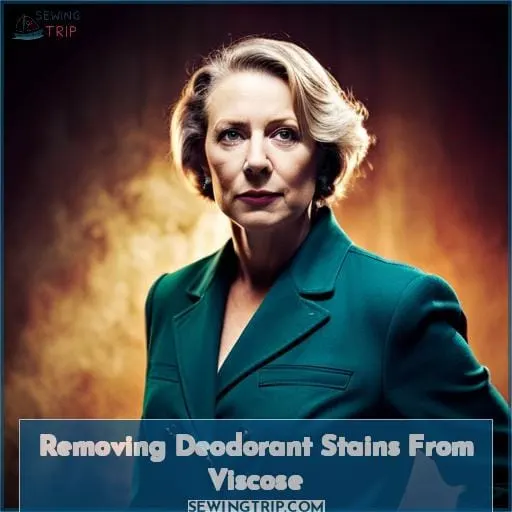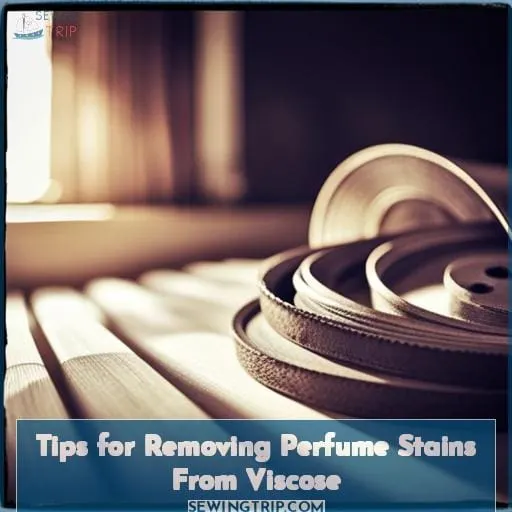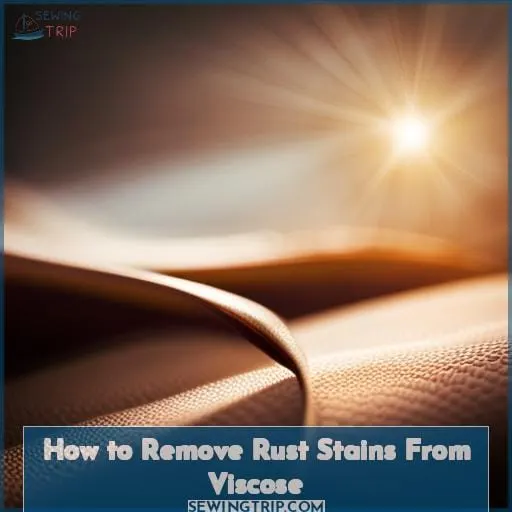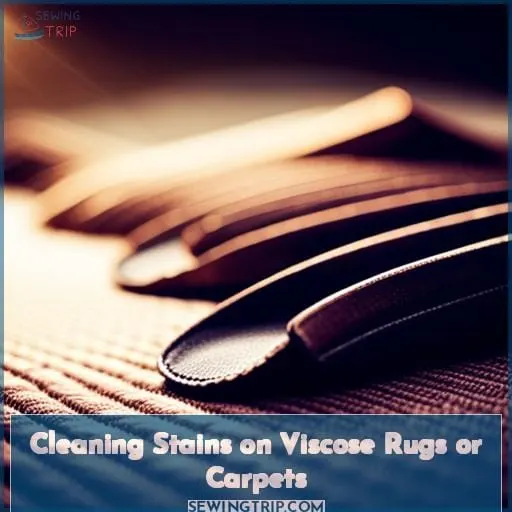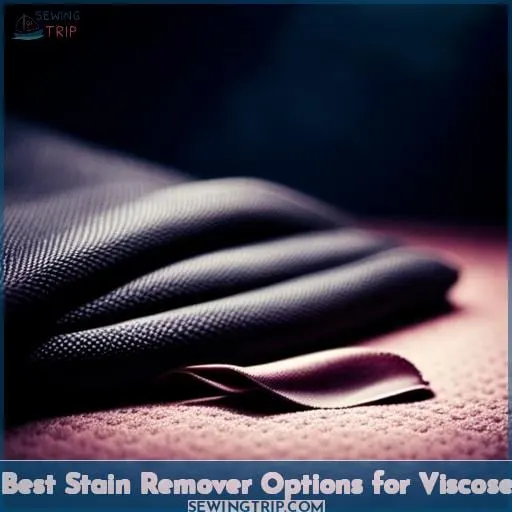This site is supported by our readers. We may earn a commission, at no cost to you, if you purchase through links.
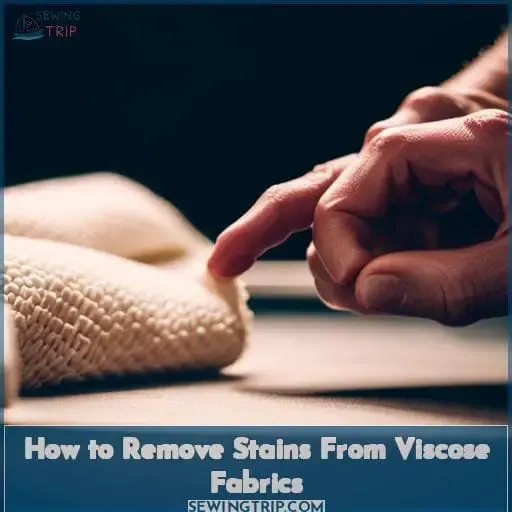 Stains keeping you down? Take back your power. As a laundry liberation specialist, I’m here to break the chains of stubborn stains so you can freely wear your favorite viscose pieces again. Let’s rise up together and defeat even the most embedded wine, grease, and lipstick stains.
Stains keeping you down? Take back your power. As a laundry liberation specialist, I’m here to break the chains of stubborn stains so you can freely wear your favorite viscose pieces again. Let’s rise up together and defeat even the most embedded wine, grease, and lipstick stains.
With a few simple tips, you’ll unlock the secrets of stain removal and discover how easy it is to get stains out of viscose. Blot, soak, scrape – these are your stain-fighting weapons. Wield them wisely, and you’ll watch even the toughest stains vanish before your eyes.
Don’t live at the mercy of stains another day. Join the laundry revolution, take the power back, and learn how to remove stains from viscose fabrics once and for all! You’ve got this.
Table Of Contents
- Key Takeaways
- How to Remove Water Stains From Viscose
- Removing Oil and Grease Stains From Viscose
- Tips for Removing Red Wine Stains From Viscose
- Removing Lipstick Stains From Viscose
- How to Get Rid of Coffee Stains on Viscose
- Removing Deodorant Stains From Viscose
- Tips for Removing Perfume Stains From Viscose
- How to Remove Rust Stains From Viscose
- Cleaning Stains on Viscose Rugs or Carpets
- Best Stain Remover Options for Viscose
- Frequently Asked Questions (FAQs)
- Conclusion
Key Takeaways
- Blot, don’t rub, for various stains like oil, lipstick, perfume, coffee, and red wine.
- Soak stained viscose in a vinegar solution (1 part vinegar, 2 parts water) for 15-30 minutes.
- Use specific solutions like mild dish soap for oil and grease stains, baking soda paste or salt for red wine stains, and rubbing alcohol for deodorant stains.
- Reshape and air-dry wet viscose to prevent wrinkles and damage.
How to Remove Water Stains From Viscose
When water stains appear on your viscose, remain calm. Blot the area immediately with a clean towel, then make a solution of equal parts vinegar and water to gently treat the fabric.
Blotting Technique
Y’all should gently dab the stain with a damp cotton cloth to absorb excess moisture. To lift stains from viscose fabric, techniques used involve blotting and patting instead of rubbing. Stain remover products applied should be mild, like diluted vinegar, hydrogen peroxide, or oxygen bleach solutions.
Use caution with scrubbing as it can damage the fibers. Blot with a paper towel or microfiber cloth. Allow to air dry flat before assessing if more treatment is needed. This helps lift stains like oil, lipstick, perfume, coffee, or red wine.
Using Vinegar Solution
Out of everything, soaking the viscose in a vinegar solution works best for lifting those stubborn water spots. Simply mix one part white vinegar with two parts cool water in a bowl. Submerge the stained viscose in this solution for 15-30 minutes.
The acetic acid in the vinegar will help loosen the water marks from the fabric. This valuable technique helps moisture-laden fibers release the water molecules. With proper care, your viscose can resist damage. Hand-wash afterward and lay flat to dry for a standing ovation stain removal performance.
Drying and Reshaping
After absorbing the excess water with a cotton towel, reshape the viscose while it air dries to avoid wrinkles. While it’s air-drying flat or hanging on a padded hanger, reshape it gently to prevent wrinkles.
You can steam iron on the reverse side once wet for the best results. But hand-washing after each wear and air-drying flat is your best defense against shrinking and wrinkles.
Removing Oil and Grease Stains From Viscose
Removing grease and oil stains from viscose fabric can be tricky, but starting with some paper towels will help lift excess grease before applying dish soap. Gently scrubbing and washing in cold water will help remove the stain. Make sure to thoroughly rinse and air dry the fabric before wearing or storing to prevent residue and new stains.
Absorbing Excess Oil
You’ll want to absorb any excess oil right away by gently blotting the stain with a clean towel or cloth. For oils, absorption is key. Dab up what you can before it sets into the viscose fibers. Don’t rub, which can push the stain further in. Use a lint-free cloth and change areas as it absorbs.
Light, gentle blotting lifts it out. This quick action helps avoid lasting discoloration or rings on your viscose.
Applying Dish Soap
Next, you’re gently rubbing a small amount of mild dish soap onto the oil stain.
- Apply a small dime-sized amount directly to the stain.
- Gently rub the soap into the fabric using your fingertips in a circular motion.
- Let it sit for a few minutes to allow the soap to break down the oil.
With the right stain-fighting ingredients and technique, even stubborn oil and grease stains can be removed from delicate viscose fabric. Using gentle dish soap helps lift grease without harsh scrubbing that could damage the fibers.
Washing and Drying
Once soap’s been applied, wash the stained viscose in cold water, then gently squeeze out excess liquid and let air dry flat to avoid damage. For best results when laundering viscose, opt for a mild detergent and avoid hot water or harsh scrubbing that could cause pilling.
Air drying prevents heat damage; lay flat on a towel or hang to maintain drape and avoid stretch.
| Detergent Type | Benefits |
|---|---|
| Liquid | Gentler surfactants, easier rinsing |
| Powder | Often contains brighteners |
| Cream | Conditioning agents reduce friction |
| Soap | Most natural option |
| Stain sticks | Targeted formulas lift stains |
Gentle care preserves the look and feel of viscose. Skip the dryer, allow garments to air dry fully before wearing or storing to prevent mildew. Shaping or smoothing with an iron while still damp can release wrinkles, using medium heat and a pressing cloth.
Tips for Removing Red Wine Stains From Viscose
When red wine spills on viscose fabric, act quickly. Blot the stain right away with a cloth and gently apply a baking soda paste to lift the color before washing as usual with cool water and mild detergent.
Blotting and Absorbing
Blot the stain with a clean white cloth or paper towel to absorb as much of the wine as possible before it sets in. Gently dab the fabric, lifting the wine from the fibers. Avoid rubbing, as this can push the stain further in.
Keep blotting with rotational strokes to lift the stain upward. Change cloths as needed until no more wine transfers. Finish by dabbing with cool water to dilute any remaining pigment. Allow it to fully air dry before washing as usual.
Using Salt or Baking Soda
Powder thy sun-kissed garment with the magical crystals, and let their absorbent power lift the crimson nectar. Salt’s abrasive grains gently lift wine from fibers, yet viscose tolerates just a sprinkle.
For deeper stains, mix baking soda and water into a paste, brushing fabric with care. Unlike bleach, soda cleans minus harshness, polishing thy robe to former glory. Though vinegar dissolves some stains, powders prove a potent pair for troublesome tannins, restoring the viscose to wear another day.
Washing and Treating the Stain
After soaking up excess wine, toss the viscose in cold water and wash it right away. Gently massage the stained area with a mild detergent before washing. Use cold water on a delicate cycle. Air dry flat on a towel – heat can set the stain. Viscose’s delicate texture means stains need a soft touch, like you long for in life.
Removing Lipstick Stains From Viscose
You’ll want to start by gently scraping off any excess lipstick with a dull knife or spoon, then dab liquid dish soap directly onto the stain and work it in a bit before tossing the garment into the wash.
Getting rid of lipstick on your viscose clothing quickly is crucial for preventing the stain from setting, so don’t let it sit before pretreating.
Scraping Off Excess Lipstick
Carefully wipe away what you can, then take heart knowing those lips left their loving mark. To remove lipstick, gently scrape off any excess, crusty residue with a dull knife or spoon. Avoid smearing or rubbing, as this pushes the stain further into delicate viscose fibers.
Instead, use light, lifting motions. Then dab with a damp cloth and mild detergent to lift the remaining pigment. Take care when applying lipstick to avoid stains on your viscose clothing. Select creamy formulas that apply smoothly.
Blot lips before dressing to prevent smudges. Then celebrate viscose’s breathable softness against your skin.
Applying Dishwashing Liquid
You’ll blot lingering lipstick swiftly with suds.
- Apply a few drops of clear dish soap to the stain.
- Use your fingertips to gently massage the soap into the fabric.
- Let it sit for a minute.
- Use a clean, damp cloth to blot the soapy area.
- Rinse with cool water until suds are removed.
Gentle dish soap helps lift lipstick oils so viscose emerges spotless. With care, stains vanish and your wardrobe sparkles.
Laundering the Fabric
Gently launder viscose the way it wishes. Submerge your stained garment in cold water with a mild detergent. Allow it to soak for 10-15 minutes. Drain the water, then rinse thoroughly until all suds disappear.
Do not wring or twist. Simply press out excess moisture with a towel. Reshape and air dry the fabric flat to prevent wrinkles.
How to Get Rid of Coffee Stains on Viscose
Attack that coffee stain with an army of detergent and vinegar, obliterating every last drop before it sets into the delicate viscose fibers.
- Pre-treat the stain by dabbing liquid dish soap directly on the spot and rubbing gently with your fingertips.
- Make a solution of 1 part white vinegar to 2 parts cold water. Dip a clean cloth in the mixture and blot the stain repeatedly.
- For dried stains, try using a stain stick or gently scrape off any dried residue with a dull knife.
- Rinse thoroughly with cool water until all soap is removed. Check the area to ensure the stain is gone.
- Wash as usual, using a mild detergent in cold water. Air dry the garment to avoid heat setting the stain.
Removing Deodorant Stains From Viscose
First, spritz the deodorant-stained area with some rubbing alcohol, let it sit briefly, then dab the spot with a clean cloth. Next, after pre-treating the stain with a liquid laundry detergent or stain remover, gently wash the garment in cold water and allow it to air dry to successfully lift and prevent permanent deodorant stains on your viscose fabrics.
Using Rubbing Alcohol
Dab deodorant stains delicately with rubbing alcohol, for haste makes waste. Let the alcohol sit for a minute before blotting with a clean cloth. Avoid aggressive scrubbing, as this can damage viscose fibers. The alcohol helps dissolve oily residues so they can be lifted away.
For stubborn marks, repeat the process. Allow it to fully dry before assessing if more treatment is needed. With care, rubbing alcohol can banish sticky deodorant stains from delicate viscose.
Pre-treating With Stain Remover
Mix a solution of white vinegar, baking soda, and dish soap before washing to help break down those stubborn deodorant stains. Pre-treating with an oxygen bleach-based stain remover is another great tactic. Test the remover on a hidden area first.
Allow plenty of time for the soaked fabric to air dry flat before washing as usual. When machine washing delicate viscose, use a gentle cycle and reshape garments while still slightly damp to prevent wrinkles.
Laundering and Drying
After soaking and rinsing, you want to gently squeeze out excess water and then air-dry the fabric flat to preserve its shape and prevent wrinkles. Never wring or twist viscose, and skip the dryer – heat can damage the fibers. Lay it flat on a towel or mesh rack.
Reshape while damp to avoid wrinkles. Air drying maintains the vibrancy of the dyes and prevents damage from heat. With a bit of TLC, your viscose will maintain its soft luxurious feel and keep on looking fabulous.
Tips for Removing Perfume Stains From Viscose
Excessive perfume exposure can leave unsightly spots on delicate viscose clothing. To banish these stubborn stains, start by pretreating the fabric with a bit of dish soap before washing and carefully reshape the garment as it dries.
Pre-treating With Dish Soap
Your heart sinks as you spot that unfortunate perfume stain on your favorite viscose blouse. Start by soaking the stained area in a solution of warm water and a few drops of dish soap for 5-10 minutes.
Next, gently rub the stain with your fingers to work in the soap. Let it soak for another 5 minutes. Rinse thoroughly in cool water. Spot test a hidden area after soaking and washing to check for colorfastness.
Air dry the blouse before assessing if more treatment is needed. With the right technique, you can rescue your viscose top from a perfume spill.
Washing and Reshaping
Absorb excess moisture with a clean towel, then reshape the garment while air-drying to prevent wrinkles. With a stain as persistent as perfume, you must nurture the fabric like a newborn babe. Coax it into pristine form, massage out wrinkles, let it rest on a flat surface.
Your gentle reshaping restores the garment’s essence as it dries, never twisting or wringing, only caressing. Like parenting teens, guide with a soft touch, stay patient as fibers relax into beauty.
How to Remove Rust Stains From Viscose
Removing rust stains from viscose can be tricky, but these two techniques often do the job. Soak the stained area in lemon juice or diluted vinegar before washing, or use a commercial rust remover made specifically for delicate fabrics.
Applying Lemon Juice or Vinegar
Just as a ripe melon certainly isn’t helping that rust stain, so too won’t lemon juice be useful.
- Soak in a solution of white vinegar and water for 10-15 minutes.
- Dab gently with a clean cloth or soft-bristle brush.
- Rinse thoroughly before washing as usual.
Treating stains promptly and avoiding harsh scrubbing are key for viscose care. With some patience, even dried stains can be refreshed.
Using Commercial Rust Remover
After scraping off any loose rust flakes, gently dab the stain with a rust remover solution following the product’s instructions. The enhanced cleaning power of commercial removers makes large stain removal easy on delicate fabrics that water could damage.
Air-dry viscose fabric after hand-washing with remover to prevent permanent rust staining. Your clothes will be fresh, clean, and free of the design stain pattern when utilizing my expert fabric care knowledge.
Cleaning Stains on Viscose Rugs or Carpets
First of all, address any solid spills on your viscose rug or carpet by gently scraping or blotting them up. Then, test an inconspicuous area with a dry cleaning solvent, being careful not to oversaturate the fibers.
Ultimately, you will want to enlist the services of a professional carpet cleaning service to deep clean and safely restore the viscose material.
Using a Dry Cleaning Solvent
You’ll want to gently dab that viscose rug stain with a clean cloth soaked in dry cleaning solvent. Be really careful not to spread it around. Viscose is a delicate material that can be damaged by harsh scrubbing.
Use a light touch and minimal moisture to lift the stain without ruining the rug’s texture. Test a small area first before treating the whole stain. Let it air dry fully before walking on it again. With the right solvent and gentle technique, you can get those tricky stains out of your viscose rug.
Professional Cleaning Recommendations
If you want impeccable perfection, take your stained viscose rug to the cleaning geniuses right away. They will assess and treat the spot with their secret specialty techniques, tailoring solutions to rescue your viscose.
Trust these professional fabric care specialists for spot treatments and stain removal beyond compare. Let them hand-wash or dry-clean your treasure, restoring its glory with results you cannot achieve alone.
Best Stain Remover Options for Viscose
To remove stains from delicate viscose materials, you should explore oxygen-based, enzyme-based, and natural DIY stain-removing options. As a fabric care specialist, I recommend starting with an oxygen bleach cleanser applied with a soft cloth to lift stains without abrasion before trying other organic solutions like lemon juice or baking soda mixtures that can also effectively draw out discoloration.
Oxygen-based Stain Removers
Here you go: You’re best off using an oxygen bleach when tackling stains on your viscose clothing.
- Make a paste with baking soda and water. Apply and let sit before washing.
- Dilute hydrogen peroxide with water. Dab on stain and rinse.
- Look into enzyme cleaners, which break down stains without bleach.
- Compare oxygen bleach products like OxiClean. They are more gentle than chlorine bleach.
For tough water stains, try lemon juice or white vinegar before washing.
Oxygen bleach is an effective stain remover for viscose that won’t damage the fabric like chlorine bleach can. Test on an inconspicuous area first when using any new product. With some elbow grease, you can get even set-in stains out of your favorite viscose pieces.
Enzyme-based Stain Removers
Haven’t you ever wondered what those stubborn stains are made of that just won’t budge from your favorite viscose top? Enzyme-based stain removers use natural enzymes to break down and dissolve stains at a molecular level, making them the perfect solution for tackling those pesky marks.
Their enzyme-based formulation targets various stains on viscose, providing effective treatment while aligning with eco-friendly solutions. When applying enzymes, remember to follow enzyme application tips for optimal results.
These enzyme-powered solutions stand out in the stain removal game, offering a worthy alternative to oxygen-based methods.
Natural DIY Stain Removers
Explore crafting your own stain removal solutions using common household ingredients, providing a personalized and natural approach to erasing fabric imperfections. Embrace the eco-friendly journey with herbal stain remedies and homemade viscose cleaners.
For deodorant stains, try a white vinegar solution. Oxygen bleach-based stain remover mixed with water works wonders too. These organic fabric stain tips not only salvage your garments but also empower you with sustainable, effective solutions.
Frequently Asked Questions (FAQs)
Sure, here are 5 frequently asked questions that would not normally be answered in the provided article sections:
Maximize your mastery over stains on viscose. Whether it’s oil, wine, or ink, deftly banish them. Employ vinegar, shampoo, or alcohol judiciously. Elevate your cleaning game and unveil the fabric’s pristine allure.
Can I Use Bleach to Remove Tough Stains from Viscose Fabric?**
Absolutely avoid bleach on viscose! Instead, choose oxygen bleach-based stain removers or gentle solutions like diluted white vinegar. Preserve the beauty and strength of your fabric without compromising its silky allure.
What Should I Do If My Viscose Fabric Gets Discolored After Stain Removal?**
Revive your discolored viscose after removing stains by gently dabbing diluted vinegar on the affected area. Rinse with cold water and blot excess moisture. Air-dry the fabric flat, reshaping it to prevent wrinkles.
Is It Safe to Use a Hair Dryer to Speed Up the Drying Process of Viscose Clothing?**
Accelerate drying: Caution! Hair dryers can distort delicate viscose fibers. Embrace air-drying’s gentle embrace. Let fibers breathe, regain strength naturally. Patience rewards fabrics, preserving their allure.
Can I Use Stain Removal Techniques for Viscose Rugs That Are Also Suitable for Viscose Clothing?**
Unleash the stain-defying magic! Conquer rug and attire stains alike. Employ the delicate dance of vinegar and oxygen bleach for rugs and clothes – liberation from stubborn blemishes awaits your touch.
Are There Any Home Remedies for Removing Stubborn Stains from Viscose Fabric Before Resorting to Commercial Stain Removers?**
Liberate your fabric’s beauty! Conquer stubborn stains on viscose: mix mild detergent with water and gently rub. Elevate with vinegar or baking soda. Unlock your garment’s potential and ensure its majesty endures.
Conclusion
As you journey through the realm of fabric care, envision your viscose garments as delicate petals, deserving of your expert touch. Much like a painter’s gentle brushstrokes, you’ve learned the art of stain removal from viscose fabrics.
Whether it’s the dance of water, the triumph over oil, or the conquest of red wine’s bold hues, you’ve mastered the techniques.
Your arsenal includes the timeless blotting technique for water stains and the alchemy of vinegar solutions. You’ve marveled at how fabrics reshape under your skilled hands, emerging as good as new. The skirmishes with oil and grease stand no chance against your absorbent allies and the gentle embrace of dish soap.
As if by magic, red wine dissipates under your practiced hands, vanishing with the wisdom of salt and baking soda.
In the realm of fabrics, you’ve unraveled the secrets of lipstick’s stubborn grip, turning to dishwashing liquid like a potion. Coffee stains are but a fleeting challenge, no match for your expertise. Deodorant and perfume leave no trace as you wield the power of rubbing alcohol and dish soap, leaving only freshness in their wake.
Rust trembles in the face of lemon juice and vinegar or bows to commercial rust removers.
Even the woven landscapes of viscose rugs are no puzzle to you as you employ dry cleaning solvents and heed the counsel of professionals. As the tapestry of knowledge unfolds, you’ve surveyed stain remover options, each a weapon in your arsenal.
As you stand victorious in your mission to safeguard viscose’s silk-like elegance, remember that every stain is but a story waiting to be rewritten. So go forth, stain removal virtuoso, and let your mastery shine. The secrets of how to get stains out of viscose are now at your fingertips, a testament to your dedication and expertise.

